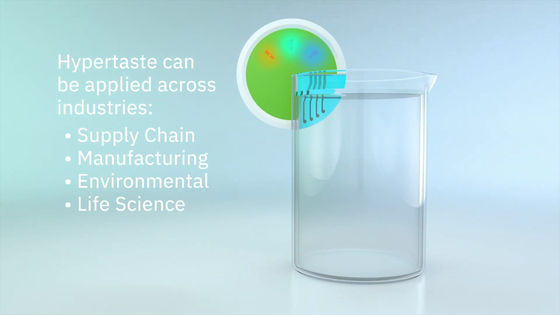IBM Develops 'Electronic Tongue' That Can Determine What Liquid Is Instantly Using AI

by
The taste of human beings is the event of evolution for thousands of years. Humans have sensitive tongues, which enable them to perceive substances that are harmful to the human body and to enjoy food and drinks. However, mechanical sensors do not yet have high accuracy in substance recognition like human tongue. Therefore, IBM is developing an electronic tongue “ Hypertaste ( hypertaste )” that can easily determine whether a liquid is suitable for drinking with a small portable device.
Hypertaste: An AI-assisted e-tongue for fast and portable fingerprinting of complex liquids | IBM Research Blog
https://www.ibm.com/blogs/research/20019/07/hypertaste-ai-assisted-etongue/
The 'hypertaste' developed by IBM is a device that analyzes liquid using artificial intelligence (AI). You can see what a hypertaste is in one shot by looking at the following movie published by IBM.
IBM Hypertaste: An AI-assisted e-tongue for fast and portable fingerprinting of complex liquids-YouTube
Hyper taste is a portable 'electronic tongue' that makes it possible to use AI to quickly identify complex liquids.

HyperTaste enables advanced liquid analysis with a minimum of hardware by using a technology called 'combinatorial sensing'. In combinatorial sensing, it is a pattern that identifies the characteristics of the liquid to be analyzed by constructing a cross-sensing sensor array that allows individual sensors to react simultaneously with different chemicals.

Use the cross-sensitive sensor array (blue part) dipped in liquid.

When the sensor part is dipped in liquid, the AI assist sensor recognizes the chemical pattern of the liquid from the combination pattern resembling human's 'taste' and 'smell' sense.

The hyper taste memorizes the voltage signal unique to each liquid by the sensor array, and it distinguishes the liquid by collecting different voltage information for each liquid as “orange juice is this number”. The sensor part is designed to be replaceable based on polymer.

The collected data will be analyzed by trained machine learning algorithm on the terminal or on the cloud. Machine learning algorithms determine which of the fluid databases are most scientifically similar to the fluid being examined.

Analysis results can be checked via the mobile app. In addition, during proof-of-concept testing, it seems that the time taken for analysis results to appear was less than a minute.

IBM claims that hypertaste may be active in a variety of industries, and is particularly focused on applications in the fields of supply chains, manufacturing, environment, and life sciences. IBM has cited several cases, such as water quality testing in lakes and rivers, confirmation of ingredients by manufacturers, and identification of counterfeit wines and whiskeys.

Related Posts:







